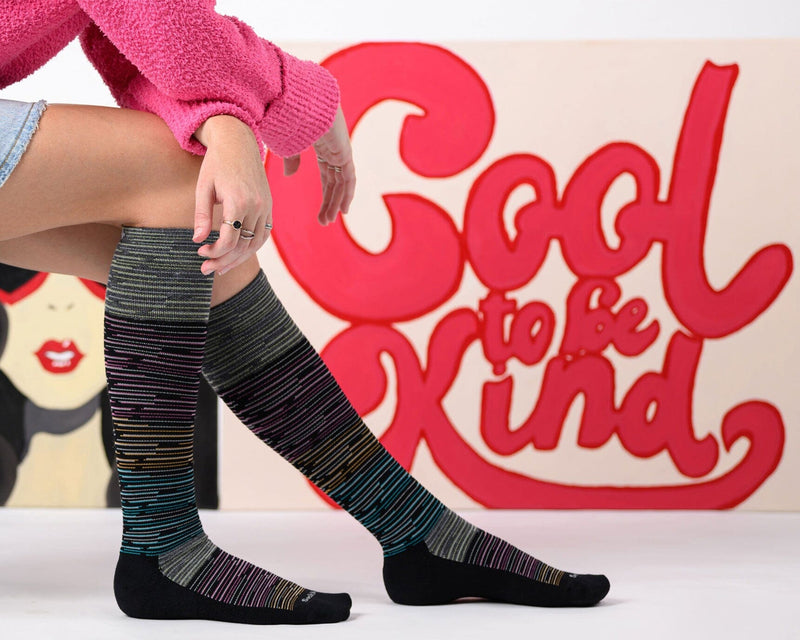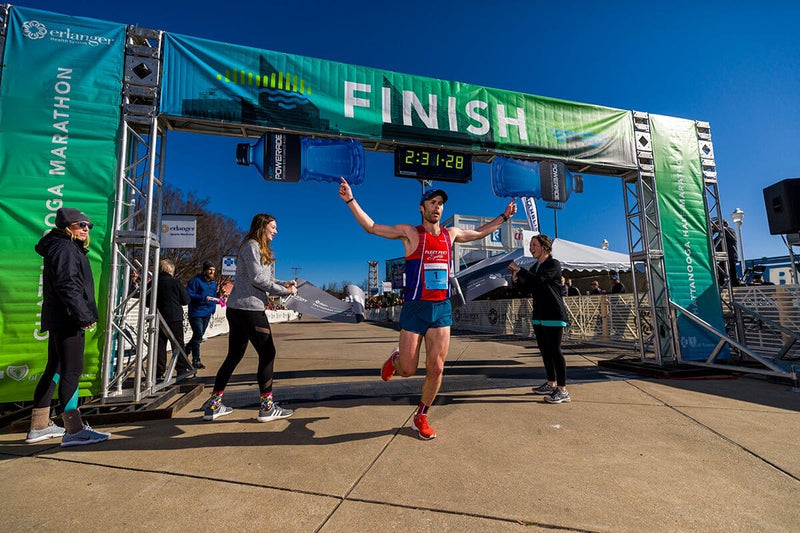
Have you ever felt like your legs are carrying the weight of the world? You're not alone. Tired, achy legs can be a real drag. But what if there was a simple solution to help alleviate discomfort and boost your energy? Compression socks might just be the answer. Designed to improve blood circulation and reduce swelling, these versatile socks have become a popular choice for athletes, travelers, and anyone seeking relief from tired legs.
Key Takeaways
- Compression socks are snug-fitting stockings that improve leg blood flow by applying graduated pressure, reducing swelling and discomfort for athletes, travelers, and those who work in standing positions.
- Wearing compression socks provides various health benefits, such as boosting circulation, reducing swelling, alleviating pain, enhancing muscle recovery, preventing varicose veins, and offering support during pregnancy.
- Ideal for travel and post-surgery recovery, these socks promote blood circulation, reduce swelling, and ease discomfort.
- Choosing compression socks involves considering compression level, size, material, style, and activity level to ensure optimal fit and benefits.
- For proper use, put on compression socks in the morning, make sure they fit snugly but comfortably, smooth out any wrinkles, and wear them daily for the best results.
- Care for your compression socks by washing them gently in cold water, air drying them, and replacing them every 3-6 months.
What Are Compression Socks?
Compression socks are snug-fitting stockings that promote better blood flow in your legs. Whether you're an athlete, an avid traveler, or someone who stands all day, these socks can be a game-changer for your leg health.
How Do Compression Socks Work?
Compression socks work their magic by applying gradually decreasing pressure from your ankles to your calves. They gently squeeze your legs, promoting blood flow back up to your heart. This helps reduce swelling and alleviate discomfort. Graduated compression is a fit that is a bit tighter around the foot and ankle, and then relaxes slightly up through the calf of the sock. This fit is found in our over the calf and crew styles.
Types of Compression Socks
Picking the right compression socks can be a bit like choosing ice cream—so many options! Here’s a scoop of the most popular types:
- Knee-High/Over the Calf: Great for runners, people who sit or stand for long periods of time, and anyone who needs extra leg support. They cover your leg from the foot to the knee, providing optimal graduated compression.
- Crews: Perfect for those looking for graduated compression without the height. Crew socks sit right at the middle of the calf but still have the benefits of graduated compression–it’s a win-win!
- Micros and Quarters: Small but mighty, these socks are perfect for anyone who wants a little bit of a boost in their day. Though the socks do not have graduated compression, they offer a gentle squeeze in the arch of your foot, giving you support for any activity.
Benefits Of Compression Socks
Compression socks can be a game-changer for your health and comfort. Whether you're into wellness, love outdoor activities, or just want a stylish boost, they've got you covered.
Improved Circulation
Compression socks promote better blood flow. They apply gentle pressure that starts at the ankle and decreases up the leg. This boosts circulation, encouraging blood to move upward and reducing the chance of pooling and clotting.
Reduction of Swelling
Got swollen legs, feet, or ankles? Compression socks can help. By improving circulation, they reduce swelling. They’re perfect if you spend a lot of time sitting or standing—or if you have certain medical conditions like lymphedema.
Pain Relief
Suffering from leg pain? These socks can alleviate that discomfort. Conditions like varicose veins, deep vein thrombosis, and chronic venous insufficiency can cause pain, and compression socks can help alleviate that pain.
Muscle Recovery and Exercise Performance
Athletes, listen up! Compression socks aid muscle recovery by promoting blood flow. They can also enhance exercise performance. Less soreness, more gains—what's not to love?
Prevention of Varicose Veins
Compression socks can help prevent varicose veins. By promoting healthier circulation, they reduce the chances of these unsightly, painful veins forming. Think of it as a stylish way to maintain leg health.
Support During Pregnancy
Expecting mothers, rejoice! Compression socks provide much-needed leg support. They alleviate swelling and improve circulation, making those long nine months a bit more comfortable.
When To Use Compression Socks
Wondering when to wear compression socks? Let's find out the best times to put them on.
During Travel
Sitting still for hours on end sounds like a dream, right? Long flights, car rides, and bus trips often involve limited movement, which can lead to discomfort and swelling in your legs. Compression socks work their magic by promoting blood circulation and reducing swelling. You'll feel fresher and more comfortable upon arrival. So whether you're flying to Bali or taking a road trip to Grandma's, keep a pair handy.
Post-Surgery
Surgeries are no fun, and neither is the recovery process. Post-surgery, your movement is often restricted, which can slow down blood circulation. Compression socks can step in to promote better blood flow and reduce the risk of blood clots. They help alleviate swelling, making you feel a tad more comfortable during your healing process. Trust us, your legs will thank you.
How To Choose The Right Compression Socks
Choosing the right compression socks can make a big difference in promoting circulation and reducing discomfort. Let's dive into some key factors to consider so you can pick the best pair for your needs.
Compression Level
Compression socks come in different levels of pressure, measured in millimeters of mercury (mmHg). Moderate levels (15-20 mmHg) are great for everyday use and mild swelling. Firm levels (20-30 mmHg) are for moderate swelling, varicose veins, and travel.
Size
Proper fit is crucial. Compression socks should be snug but not uncomfortably tight. Measure your leg's circumference at the ankle, calf, and sometimes the thigh. Many brands provide sizing charts to help you find the perfect fit.
Material
Compression socks are typically made from a blend of nylon, spandex, and natural fibers like merino wool. Nylon and spandex offer flexibility and durability, while merino wool provides added softness, breathability, and temperature regulation.
Style
Compression socks come in various styles — knee-high, crews, quarters, and micros. All are popular for daily use and can benefit users in different ways.
Activity Level
Consider your daily activities. For sports, look for breathable fabrics. For travel, opt for easy-to-put-on styles with moderate compression. Office-goers might prefer seamless, discreet designs under their work attire.
How To Properly Wear Compression Socks
Alright, you've got your shiny new compression socks. Now what? Let’s look into how to wear them like a pro.
Choose the Right Time
Morning’s probably the best time to put on your compression socks. Why? Because that's when your legs are least swollen. Trying to wrestle them on at the end of the day might feel like you're trying to fit a camel through a needle’s eye. Trust me, easier in the morning.
Proper Fit
Make sure your socks fit snugly but aren’t cutting off your circulation. You want them tight enough to promote blood flow but not so tight that they leave marks or feel like they’re giving you a reverse hug.
Ease Them On
Don’t just yank them on like regular socks. Here’s a trick:
- Turn the sock inside out up to the heel.
- Slip your foot in and gently roll the sock up your leg.
- Tug the toe part smoothly so that there are no wrinkles. Wrinkles = discomfort.
Avoid Bunching
Nobody likes a bunched-up sock. It’s uncomfortable and defeats the purpose. Make sure the fabric’s evenly distributed. No bunching around the ankles, knees, or anywhere else.
Daily Wear
Yes, daily! Wearing compression socks daily helps keep that blood pumping and reduces swelling. Take them off before bed unless otherwise directed by a healthcare professional.
How To Maintain Compression Socks
Washing and Care
Here's what you need to know: compression socks last longer and stay effective when you care for them properly. Hand wash them if you have the patience; otherwise, machine wash on a gentle cycle in cold water. Air dry them to maintain elasticity.
Know When to Replace
Compression socks aren’t forever. Over time, they lose their elasticity. If your socks feel loose or aren’t providing relief, it’s time for a new pair. Generally, every 3-6 months is a good rule of thumb.
Summing Up
Compression socks offer a range of benefits, from improved circulation to enhanced recovery. They can be particularly helpful for managing conditions like varicose veins and providing support during pregnancy. By choosing the right compression level, wearing them correctly, and caring for them properly, you can maximize their benefits and enjoy a healthier, more comfortable lifestyle.
Upgrade your daily routine with Sockwell. Our Merino Wool compression socks provide superior comfort and performance. Discover the Sockwell collection today and feel the difference.



